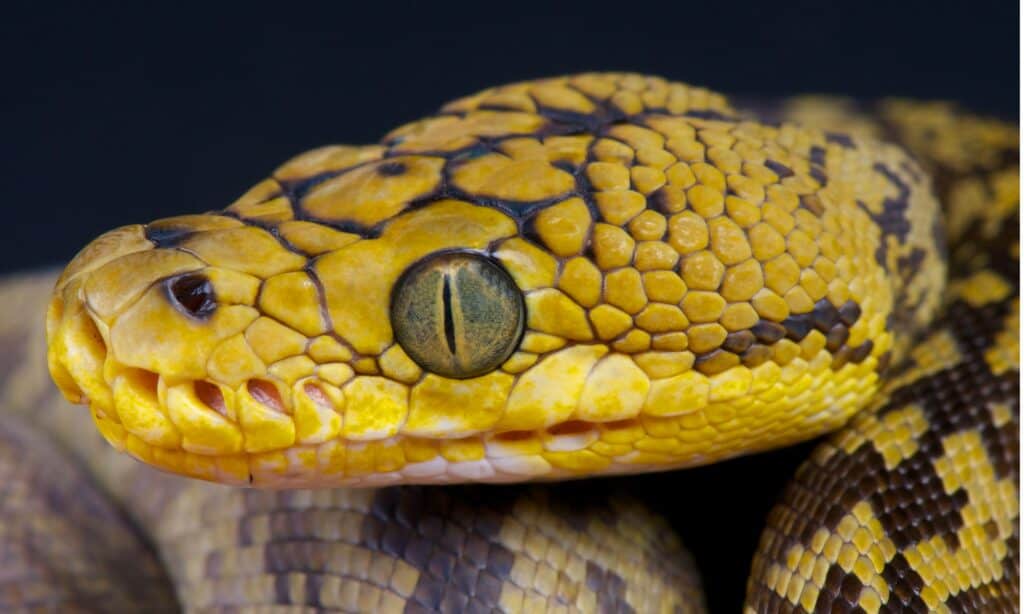Timor python
Malayopython timoriensis
Ironically, Timor pythons have never been found on the island of Timor.
Advertisement
Timor python Scientific Classification
- Kingdom
- Animalia
- Phylum
- Chordata
- Class
- Reptilia
- Order
- Squamata
- Family
- Pythonidae
- Genus
- Malayopython
- Scientific Name
- Malayopython timoriensis
Read our Complete Guide to Classification of Animals.
Timor python Conservation Status
Timor python Facts
- Prey
- Rodents, birds, small reptiles
- Name Of Young
- Neonate, hatchling, snakelet
- Group Behavior
- Solitary except during mating season
- Fun Fact
- Ironically, Timor pythons have never been found on the island of Timor.
- Estimated Population Size
- Decreasing, but unknown
- Biggest Threat
- Over-harvesting for the pet trade and habitat destruction
- Most Distinctive Feature
- Two-toned color pattern that fades to solid brown at the back half of the body
- Other Name(s)
- Lesser sundas python
- Litter Size
- About 5 eggs
- Diet for this Fish
- Omnivore
- Lifestyle
- Nocturnal
- Crepuscular
- Number Of Species
- 1
- Location
- Lesser Sundas Islands near Timor
Timor python Physical Characteristics
- Color
- Brown
- Yellow
- Light-Brown
- Skin Type
- Scales
- Lifespan
- 20+ years
- Weight
- Up to 20 pounds
- Length
- 6-7 feet
- Age of Sexual Maturity
- About 4 years
- Venomous
- No
- Aggression
- Medium
View all of the Timor python images!
The Timor python is the closest relative to the reticulated python and is a dwarf species.
This shy and elusive snake is native to the islands around Timor, and its beautiful color pattern makes it an attractive pet snake. It is nonvenomous and not considered dangerous to people, even though its closest relative is dangerous to people, pets, and livestock.
Incredible Timor Python Facts
- This high-strung python moves fast, although it hasn’t been officially clocked. It behaves more like a colubrid than a python and is very nervous with quick movements.
- Its name is misleading because it doesn’t live on the island of Timor but on the Lesser Sundas Islands near Timor.
- It doesn’t reproduce as quickly or prolifically as other species and only lays 5-10 eggs at a time.

Scientific Name and Classification
Its scientific name is Malayopython timoriensis, and the Timor python is a nonvenomous snake in the family Pythonidae. This snake is one of two in the Malayopython genus; the other is the reticulated python. The genus name, Malayopython, is a combination of Malaysia and python because it’s a python that lives in Malaysia. Of course, there are others that inhabit Malaysia, but scientists need to differentiate them somehow.
The genus name itself is a subject of some controversy in the scientific community. Yet, it seems that, for the time being, reticulated pythons and Timor pythons will remain in the genus Malayopython. The specific name, timoriensis, refers to the island of Timor. However, this is odd because there aren’t any Timor pythons on Timor. Because of this, some people try to discourage the use of Timor python and prefer calling it the Lesser Sundas python.
Appearance
Its head is long with a blunt snout, and it has large heat-sensitive pits along its front upper labial (lip) scales and a few on its lower lip in the back. On top of its head, there are larger, somewhat symmetrical shield-shaped scales that become small and pebble-like further toward the neck. Unlike its sister species, the reticulated python, the Timor python is much more slender and not nearly as long. This species can reach about nine feet long and weigh up to 20 pounds. However, most of them average between five and eight. As with many python species, the females are typically longer than the males.
The front half of its body has a base color that ranges from greenish yellow to orange-yellow, overlayed with darker patterns, somewhat reminiscent of a scrub or amethystine python. The back half of its body is solid brown, and its entire body is highly iridescent and shines in the sunlight.

Timor pythons are a “dwarf species” and closely related to reticulated pythons.
©iStock.com/reptiles4all
Behavior
Snakes move from warmer to cooler areas and back again to manage their internal temperature. These cold-blooded reptiles use the heat from the sun and their environment to maintain their body temperature. After eating, they often retreat to a warm spot to heat up their body, which helps them digest their food.
Timor pythons are mostly terrestrial but are excellent climbers and sometimes take to the trees for shelter or while hunting prey. They are most active in the early morning and at night, making them crepuscular or nocturnal. There haven’t been many studies done on them to understand their behavior in the wild, but as pets, they are widely considered one of the most high-strung pythons. If you didn’t know better, its behavior would suggest that it is a colubrid, like a king snake. This species is really shy and somewhat temperamental; they’re not big biters but frequently musk if they’re upset.
Habitat and Diet
It’s an active snake, and the Timor python requires more attention than other python species when kept as a pet. Due to its activity level and corresponding high metabolism, the snake eats more and needs more room to move about.
In the wild, it occurs in open forests and grasslands on its native islands. It also inhabits mangroves, monsoon forests, and shrublands. Like all snakes, the Timor python is an ambush predator, but this one often forages actively to support its high metabolism; it eats rats, mice, lizards, and sometimes birds.
They’re endemic to the Lesser Sunda Islands of Flores, Solor, Lembata, Adonara, Pantar, and Lombien; sightings on Timor and Alor have never been verified.
History and Evolution
Similar to other species of snake, pythons’ ancestors were actually legged reptiles, similar to lizards and reptiles that spent more time in and near water. As you might have guessed, they either lost their legs or they became vestigial, as they became more and more unused. It is interesting to image animals evolving to have legs and then evolving to lose them! There are benefits of being extremely low to the ground when your prey is on that level!
Pythons were previously classified with boas, but modern research has shown that the pythons and boas are separate species due to convergent evolution in different parts of the world, much like monkeys evolved differently in Africa and South America while having shared ancestors. Some of the major differences are that boas give birth to live young, and pythons lay eggs. Pythons also have their heat-sensing pits on their labial scales, and boas have them in between their labial scales.
The Timor Python is one of the smaller, dwarf species. Due to its environment and available threats and prey, this python did not adapt to grow to the large size of its cousins.
Predators, Threats, Conservation, and Population
According to the IUCN, the Timor python may be rare. There’s a growing demand in the pet trade for it, and when you combine that with accelerating habitat loss, the snake is struggling in the wild. Its population is declining, but we need more research to determine how far it has gone. The Timor python is listed as a Convention on International Trade in Endangered Species of Wild Fauna and Flora Appendix II species, and legal exports are regulated.
Unlike its sister species, the reticulated python, the Timor python is not dangerous to humans. It’s too small to be dangerous, and besides, it is very shy and avoids people. Young snakes do fall prey to carnivorous animals, including birds of prey. However, adult snakes have very few predators.
Reproduction, Babies, and Lifespan
Timor pythons can live over 20 years, but scientists aren’t sure about their lifespan in the wild. These snakes typically mature and are ready to breed at somewhere around four years of age. They lay five to ten eggs and then collect them into a pile so they can incubate the eggs. The mom will not leave her eggs except to adjust the temperature. If it’s too warm, she’ll leave the eggs so they can cool off, and if it’s too cold, she’ll leave for a short time to bask.
After nine to ten weeks, the babies hatch. Like other snakes, they are fully formed and ready to look out for themselves when they hatch.
View all 133 animals that start with TTimor python FAQs (Frequently Asked Questions)
Where do Timor pythons live?
Ironically, not on Timor. They live in the open grasslands and forests on the Lesser Sundas Islands near Timor.
What do Timor pythons eat?
Like most pythons, Timor pythons are excellent rodent control. They eat mice, rats, and sometimes birds.
Are Timor pythons aggressive?
They can seem that way; they’re nervous, edgy, and tend to musk when they get scared.
Are Timor pythons pythons venomous?
Not at all! Just like other pythons, they are nonvenomous, and because of their smaller size aren’t considered dangerous to people.
Thank you for reading! Have some feedback for us? Contact the AZ Animals editorial team.
Sources
- Timor Python | Reptile Database, Available here: https://reptile-database.reptarium.cz/species?genus=Malayopython&species=timoriensis
- Timor Python | Virginia Zoo, Available here: https://virginiazoo.org/animal/timor-python/
- Genus Malayopython | RepFocus, Available here: http://www.repfocus.dk
- Timor Python | IUCN Redlist of Threatened Species, Available here: https://www.iucnredlist.org/species/104842394/104854030
- Timor Python | Smithsonian National Zoo, Available here: https://nationalzoo.si.edu/animals/timor-python
















